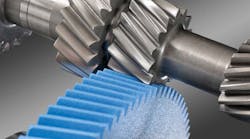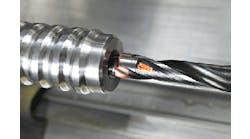A high performance 11-axis CNC system from NUM made it possible for machine tool builder Sicmat to design and build a gear honing machine that establishes a new standard for post-hardening fine finishing. Using a novel honing wheel designed with external teeth, and NUM’s “ultra-precise, application-specific” CNC program, the Grono 250 machine provides the accuracy of gear shaving – but in a process that is applied after the gear has been case hardened – and eliminates the need for shaving and grinding stages.
NUMdevelops CNC controls and designs and manufactures drives and motors. It also performs CNC and system integration with third-party products, in cooperation with machine builders and customers.
Sicmat manufactures gear-finishing machine tools for automakers and their suppliers. Until recently, Sicmat machines worked exclusively with the shaving technology, to obtain the necessary finish to gears. Companies producing medium- to high-quality gears for automotive manufacturing use this sort of finishing process widely.
However, shaving generally has to be performed before the workpiece is case hardened by heat treatment, and any heat-induced deformation then has to be corrected by grinding or honing. Sicmat set out to develop a high-power honing machine that would help gear manufacturers to accelerate production and increase throughput by reducing the number of process stages.
Until now, gear-honing automation has used highly specialized machine tools, comprising circular ring type assemblies with teeth cut in their internal face. These are expensive and time-consuming to set up, and Sicmat believed that by using a honing wheel with external teeth, the accuracy of the process could be improved to such an extent that it could replace gear shaving in many applications, with additional advantages like lower tooling costs and simpler set-up. Initial research conducted in collaboration with the engineering faculty at Italy’s Turin Polytechnic University proved the practicality of the proposed new method.
A critical requirement for honing automation is exceptionally high mechanical rigidity, to ensure accurate and repeatable results. So, Sicmat chose to base its new honing machine on the proven mechanical platform of its RASO TP 250 gear-shaving machine. Developed over many years, this machine series has exceptional stiffness and resistance to vibration – its bedplate is created from electro-welded steel filled with anti-vibration bonding, and the head, frame and tailstock are manufactured from cast iron. The platform’s physical layout provides excellent accessibility for operation and maintenance, and its vertical workpiece positioning simplifies integration with other production line automation.
The Grono 250 has eight axes of motion, plus three more axes on an associated robotic loader, all controlled by a NUM Flexium CNC system. The motors of all 11 axes are driven by high power-density NUMDrive C servodrives, and the entire system is outfitted with two NUM MDLL 3050 regulated power supplies. Each power supply is rated at 50 kW continuous and uses regenerative braking to maximize efficiency. The main machining axes are operated by direct-drive motors, while the honing wheel and workpiece axes are driven by powerful high torque motors which are synchronized and controlled by application-specific software developed by NUM.
NUM’s ability to develop custom software was a determining factor in Sicmat’s choice of CNC systems provider, according to Marco Battistotti, director of the automation developer’s Italian operation. “For this application, Sicmat needed specialist control software to provide extremely tight synchronization of the machine’s honing axes. They also wanted to partner with a CNC company that was familiar with highly integrated machine architectures and prepared to handle custom engineering in parallel with their own development efforts, which are some of NUM’s key strengths,” he said.
“The success of our collaboration was apparent immediately the first machine tests were run; the finished gears were of exceptionally high quality,” Battistotti explained.
Every stage of the honing process on the Grono 250 machine is automated for efficiency. In normal use, the case hardened workpiece is removed from the production line conveyor by a robotic handler/clamp unit, which identifies the type of gear by checking its outside diameter before transferring it to an integral pre-process measurement station. Here, the workpiece is synchronized with a secondary gear, then driven into mesh and rotated through a complete revolution; during this time, the displacement between the two axes is measured continuously to ascertain how much stock material needs to be removed from the workpiece, and this data is fed to the Flexium CNC system.
After measurement, a further robotic handler transfers the workpiece to the honing stage, where it is initially indexed before being run up to speed and synchronized with the abrasive toothed honing wheel. The honing wheel is then driven progressively into mesh with the workpiece. The two axes operate in a distinct master-slave configuration that has zero delay of the slave axis, which required NUM to create a second master for the workpiece motor. Controlling the speeds of both these axes very precisely, and fractionally varying one relative to the other, facilitates fine adjustment of the honing process.
Current-generation Grono 250 machines are capable of spindle speeds of 7,000 rpm, and Sicmat is already developing a machine with spindle speeds of 10,000 rpm, to provide even tighter process control. As soon as the honing process is complete, the workpiece is disengaged from the honing wheel, spun to remove coolant and then transferred back to the production line by the robotic handler.






